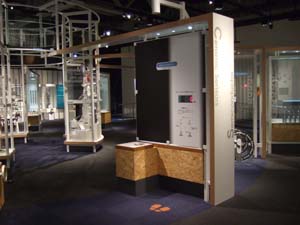Nagoya City Science Museum
TOP > Exhibition Guide > Keyword Search > Starting with "P" > piezoelectric ceramics > Ceramic Sensors
Ceramic Sensors



Purpose of Exhibition
There are some fine ceramics which have interesting characteristics. In this exhibit, an ultrasound sensor using ceramics with piezoelectricity called piezoelectric ceramics, and a temperature sensor using ceramics that has the characteristic of semiconductors are presented. Measure your height with the ultrasound sensor, and measure your hand temperature with the temperature sensor.
Additional Knowledge
[Piezoelectric Ceramics]
The electric pressure generated as force is applied and transformed is called piezoelectricity. And the object being applied with electric pressure is called a piezoelectric body. Overall, an object made of ceramic is called piezoelectric ceramics.
[Usage of Piezoelectric Ceramics]
Depending on the direction of the applied electric pressure, piezoelectric ceramics become stretchable. When alternating voltage is applied to the piezoelectric ceramics, they start vibrating. Fish finders, the ultrasound-emitting device of humidifiers, electronic buzzers, the speaker of cellular phones, and the part sending out ink in ink-jet printers are primary products using this particular characteristic. On the other hand, in products produced with the characteristic of generating electric pressure when force is applied, the ultrasound-emitting device of fish finders, lighters, and the igniter of stoves are good examples of the usage.
Other than these, piezoelectric ceramics are widely used in products such as filters that take out necessary signals of electric waves, pendulums that transmit standard signals in electric circuits, shock sensors that detect shocks, sensors that fix camera shakes, and gyro sensors in car navigation systems. They all play an important role. In this exhibit, an ultrasound sensor (ultrasound emitting and receptive device) is introduced, and the ultrasound emitted from the overhead ultrasound sensor times how fast the ultrasound travels from the sensor to your head. By calculating the distance and the time with the sound velocity, your height can be known.
[Semiconductor Ceramics and Thermistors]
Although fine ceramics are an insulator and generally do not allow electricity through, there is one which has the characteristic of semiconductors which allow electricity through, depending on the applied temperature and electric pressure. A temperature sensor made with fine ceramics, which incorporate the fact that electric resistance changes with temperature, is called a "Thermistor".
[NTC Thermistor]
In this exhibit with an "NTC thermistor", electric resistance decreases as temperature increases, and temperature is measured.
NTC thermistors are widely in use as a temperature sensor for electronic thermometers and home appliances such as air conditioners. The materials are fine ceramics, which consist of sintered oxides mixed primarily with manganese, cobalt, nickel, and iron.
*NTC (Negative Temperature Coefficient)[Other Thermistors] Besides NTC thermistors, there are other thermistors as well such as the PTC thermistor (its resistance increases as temperature rises), and the CTR thermistor, (its resistance decreases exponentially as temperature goes beyond a certain extent). Although there is the PTC thermistor, a raw material for polymer, a PTC thermistor for fine ceramics is presented here.
PTC thermistors are utilized in order to generate heat for electronic foot warmers, futon dryers, electronic rice cookers, heaters and hair dryers. Additionally, it serves to protect electronic circuits from over current and heating. The materials are fine ceramics, including a small amount of rare earth to barium titanate.
Article by Keiko Ishida, curator
